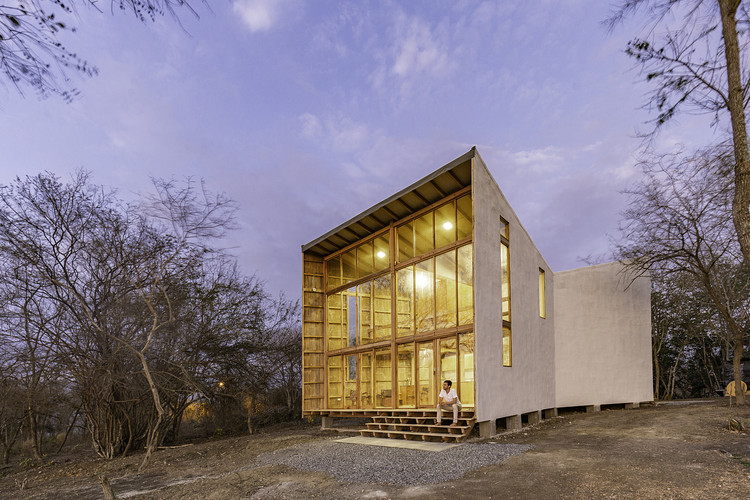Corporate Office for India Glycols Morphogenesis
2011-06-21 00:00
架构师提供的文本描述。印度糖醇公司办公室的设计体现了当今与工作场所有关的问题,并探讨了办公空间作为一种社会活动的范式。这一背景位于德里的一个不相关的郊区,导致了一个内向的方案的发展,该计划将从首要原则着手解决环境和社会经济问题。
Text description provided by the architects. The office design for the corporate office for India Glycols embodies the issues concerning the workplace today, and explores the paradigm of the office space as a social activity. Sited in a non-contextual suburban area of Delhi, the setting, led to the development of an introverted scheme that would address environmental and socio-economic issues from first principles.
正如大多数定制的公司开发项目的性质一样,建筑必须作为建筑词汇的一个组成部分,体现工作场所公平和透明的身份和企业意识形态。作为一个坚固的周长方案,内部更加流畅,形态模糊了内部和外部之间的界面。
As is the nature of most custom designed corporate developments, the building had to exemplify the identity and corporate ideology of equity and transparency in the workplace as an integral part of the architectural vocabulary. Conceived as a solid perimeter scheme with a more fluid interior, the morphology blurs the interface between the inside and outside.
Courtesy of Morphogenesis
现场的环境和环境,以及一个最佳的封闭方形体积,使建筑形式,最小的暴露面积。构造形式配置为8米宽的办公室海湾,优化了自然的白天照明,并帮助确定办公室的规划要求。堆叠系统用于形成各种开放空间:庭院、阳台、露台、绿色屋顶等。这有助于构建办公空间。中央脊柱穿过建造的体积作为共同的活动区,其他部门分支。设计的概念力量来自于空间组织,这种组织在外部和内部以及各种方案需求之间造成了重叠,从而创造了一个充满活力和创造性的工作环境。
The site surroundings and context along with an optimum enclosed square volume enabled a built form with minimum exposed surface area. The built form configured of 8m wide office bays optimizes the natural day lighting and helps to define the programmatic requirements of the office. A stacking system is used to generate a variety of open spaces; courtyards, verandahs, terraces, green roofs etc. that help to structure the office spaces. A central spine traversing the built volume serves as the common activity zone, with other departments branching out. The design’s conceptual strength comes from the spatial organization which creates overlaps between the exterior and the interior and between the various programmatic requirements, hence creating a vibrant and creative work environment.
Courtesy of Morphogenesis
能量意识通过一系列开放和半开放的空间支配着内部的空间和程序构成。在整个方案中采用被动设计技术,而不是覆盖环境层,并考虑到能源意识设计在现代工作文化中的重要性和相关性。太阳排斥是通过一个坚实的外部周界来实现的,它只允许将日光传播到办公室周围。
Energy Consciousness dictates the internal spatial and programmatic composition through a series of open and semi-open spaces. Instead of an overlay of an environmental layer, Passive design techniques are employed throughout the scheme and takes into consideration the importance and relevance of energy conscious design within the modern work culture. Solar exclusion is achieved by means of a solid external perimeter, which only permits diffused daylight into the office environs.
对人工照明的依赖大大减少,因为庭院是为了增加地板上的自然光水平。庭院有助于防止太阳进入,控制整个建筑内众多空间的温度,同时也允许足够的白天照明进入工作区。外部空间使用庭院和露台花园进行调节,方便隔热。
The reliance on artificial Lighting is substantially reduced as courtyards are created to increase natural light levels on the floor plates. The courtyards help to keep the solar ingress out and control the temperatures of a multitude of spaces throughout the building while also allowing for sufficient day lighting into the workspaces. External Spaces are tempered using courtyards and terrace gardens that facilitate thermal insulation.
带有空气腔结构的遮阳外立面、外面很小的狭缝窗户、带有小气候控制装置的庭院(遮阳和薄雾花园、水体和种植园)都有助于减少太阳能的进入。绿色屋顶和露台花园也提供了很高的隔热水平。水体有助于蒸发冷却,从而减少对人工冷却手段的依赖,也创造了一个具有社会交往潜力的城市环境的缩影。
Shaded Outer facade with air cavity construction, very small slit windows on the outside, courtyards with microclimate controls (shading and mist gardens, water bodies and plantations) all aid in reducing the solar ingress. Green Roofs and terrace gardens also provide a high level of thermal insulation. Water bodies aid in evaporative cooling thereby reducing dependence on artificial means of cooling and also create a microcosm of the civic environment rich with the potential for social transactions.
Courtesy of Morphogenesis
其基本原则是:“工作场所应表现为雇员生活中一个更灵活、更完整的部分,而不是一个由特定时间组成的单独实体。”对体积和空间的有节奏的表达产生了一种方案,它彻底背离了传统办公室的结构区分空间和主导办公室规划的开放式规划大厅的单调。IGL校园通过能源意识设计在当代印度工作文化范式中的重要性和相关性做出了文化陈述。
The underlying principle was that ‘The work place should manifest itself as a more flexible and integral part of an employee’s life rather than a separate entity of specified hours of confinement.’ Rhythmic articulation of volumes and spaces generates a scheme that is a radical departure from the structured differentiated spaces of the traditional office and the monotony of the open plan halls that have dominated office planning. The IGL campus makes a cultural statement through the importance and relevance of energy conscious design within the contemporary Indian work culture paradigm.
 举报
举报
别默默的看了,快登录帮我评论一下吧!:)
注册
登录
更多评论
相关文章
-

描边风设计中,最容易犯的8种问题分析
2018年走过了四分之一,LOGO设计趋势也清晰了LOGO设计
-

描边风设计中,最容易犯的8种问题分析
2018年走过了四分之一,LOGO设计趋势也清晰了LOGO设计
-

描边风设计中,最容易犯的8种问题分析
2018年走过了四分之一,LOGO设计趋势也清晰了LOGO设计




















































































